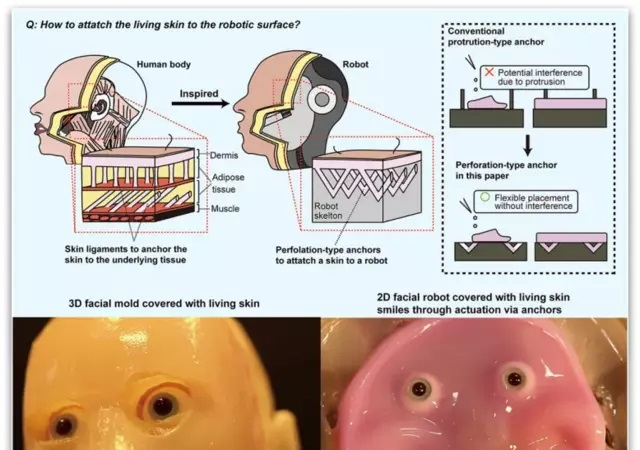
Living human skin on robots promises more realistic and communicative machines, with potential benefits for skin care research or product testing.
Human skin for robots could revolutionize both robotics and the cosmetics industry, according to scientists. The new development involves living tissue, a mixture of human skin cells grown on a collagen base, placed on a 3D printed resin substrate.

This innovative skin contains structures similar to ligaments found in humans and animals, providing strength and flexibility. Created by perforating the robot’s resin base, these structures allow tiny V-shaped cavities to be filled with living tissue, holding the robot’s skin in place.
The scientists then attached that skin to a smiling robotic face several centimeters wide, which is controlled by rods attached to the base. Another experiment involved a 3D model in the shape of a human head of similar size, although it remained stationary.
Research related to this achievement was published in the journal Cell Reports.

Advantages and disadvantages
As the development of artificial intelligence technology and other advances expand the roles required of robots, the functions required of robot skin are also beginning to change, says Michio Kawai of Harvard University. He suggests that human-like skin could improve robots’ ability to communicate with humans.
It also has significant implications for the cosmetics industry. Scientists spent a month making a small robot’s face smile, successfully replicating the creation of wrinkles.
The ability to create wrinkles on a palm-sized lab sample could simultaneously be used to test new cosmetics and skin care products that aim to prevent, delay or alleviate the formation of wrinkles, Kawai explains.
Despite these advances, Kawai acknowledges the limitations of the innovative robotic skin.
A lack of sensory functions and a lack of blood vessels to supply nutrients and moisture means it can’t survive long exposed to air, he says. Solving these problems involves the integration of neural mechanisms and perfusion channels into the skin tissue.
And that is already new research.
Source: New Scientist







